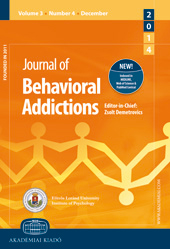Internet Gaming Disorder Among Slovenian Primary Schoolchildren: Findings From a Nationally Representative Sample of Adolescents
Internet Gaming Disorder Among Slovenian Primary Schoolchildren: Findings From a Nationally Representative Sample of Adolescents
Author(s): Halley M. Pontes, Mirna Macur, Mark D. GriffithsSubject(s): School education, Psychoanalysis, Substance abuse and addiction, Social Informatics
Published by: Akadémiai Kiadó
Keywords: Internet Gaming Disorder; Internet addiction; Slovenian samples; psychometric validation; DSM-5;
Summary/Abstract: Since the inclusion of Internet Gaming Disorder (IGD) in the latest (fifth) edition of the Diagnostic and Statistical Manual of Mental Disorders (DSM-5) as a tentative disorder, a few psychometric screening instruments have been developed to assess IGD, including the 9-item Internet Gaming Disorder Scale – Short-Form (IGDS9-SF) – a short, valid, and reliable instrument. Methods: Due to the lack of research on IGD in Slovenia, this study aimed to examine the psychometric properties of the IGDS9-SF in addition to investigating the prevalence rates of IGD in a nationally representative sample of eighth graders from Slovenia (N = 1,071). Results: The IGDS9-SF underwent rigorous psychometric scrutiny in terms of validity and reliability. Construct validation was investigated with confirmatory factor analysis to examine the factorial structure of the IGDS9-SF and a unidimensional structure appeared to fit the data well. Concurrent and criterion validation were also investigated by examining the association between IGD and relevant psychosocial and game-related measures, which warranted these forms of validity. In terms of reliability, the Slovenian version IGDS9-SF obtained excellent results regarding its internal consistency at different levels, and the test appears to be a valid and reliable instrument to assess IGD among Slovenian youth. Finally, the prevalence rates of IGD were found to be around 2.5% in the whole sample and 3.1% among gamers. Discussion and conclusion: Taken together, these results illustrate the suitability of the IGDS9-SF and warrants further research on IGD in Slovenia.
Journal: Journal of Behavioral Addictions
- Issue Year: 5/2016
- Issue No: 2
- Page Range: 304-310
- Page Count: 7
- Language: English

